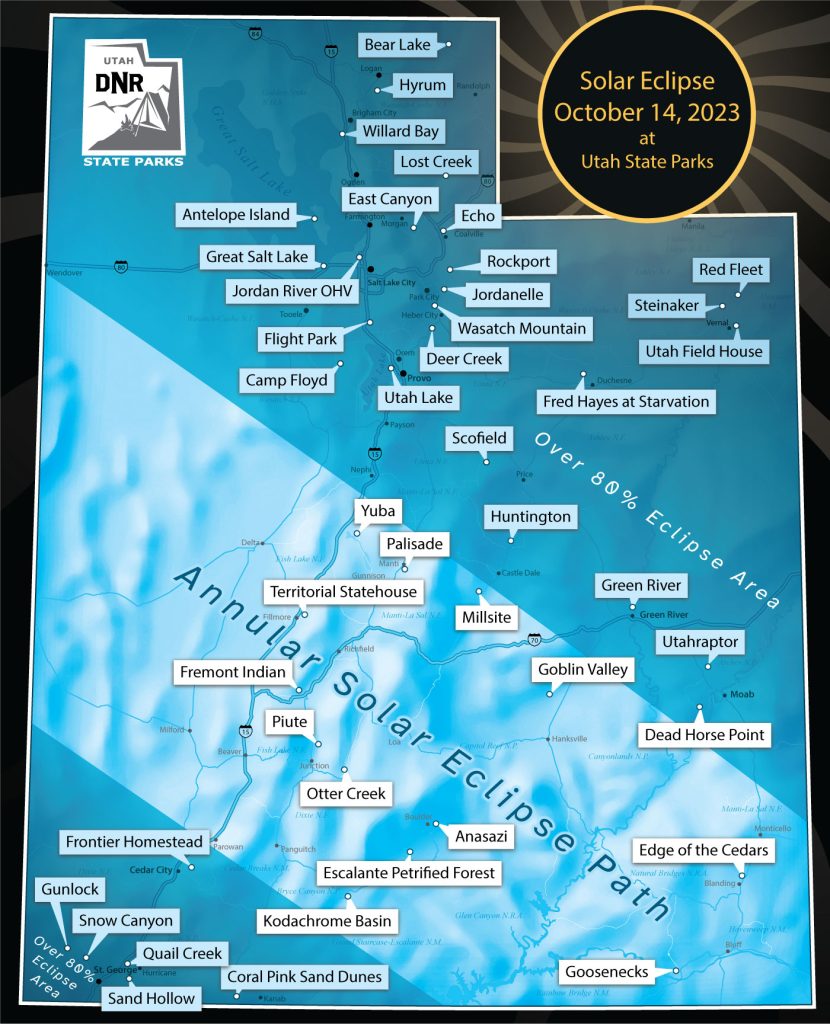Annular Solar Eclipse: October 14, 2023
Astrophiles, mark your calendars! On the morning of Saturday, October 14th, 2023, a rare annular solar eclipse will grace the skies above some of Utah’s state parks. Get ready to witness a sight that’s truly out of this world!
What Is An Annular Solar Eclipse:
During an annular solar eclipse, the moon comes between the sun and Earth when it is at its furthest distance from Earth. As a result, the moon appears smaller than the sun and does not completely obscure it, causing a radiant halo to appear around the moon, popularly known as the “ring of fire.” While it is sure to be a breathtaking spectacle, it isn’t safe to view without protective eyewear.
What To Expect:
The moon will begin to cross the sun at approximately 9:08 AM (MST) and finish by noon, with the annular totality (the “ring of fire”) occurring at around 10:28 AM. This magic moment should last about three minutes but might be longer or shorter based on your location. The closer you are to the center of the path, the longer the “ring of fire” will appear in the sky.
Planning Your Visit:
Since the eclipse occurs during Fall Break in Utah, parks will likely be busy. If you plan on camping, book your site well in advance to prevent any letdowns. You can book a campsite at Utah State Parks up to four months in advance, with the reservation period rolling, so start considering your reservations in June.
Safely Viewing The Eclipse:
During an annular solar eclipse, the moon does not completely block the sun, which means that it is crucial to take precautions to protect your eyes from the bright sunlight. Directly looking at the sun, even for a brief moment, can cause serious eye damage. It is necessary to wear protective eyewear designed for solar observation when viewing the sun. Additionally, if you plan to use devices such as cameras, binoculars, or telescopes, it is essential to use specialized solar filters to avoid potential serious harm.
What To Bring:
Due to the expected high visitation and limited supply, it’s recommended that you bring your own protective eyewear, although some parks may have them available for purchase.
Also, you might be in the sun for a long time if you want to catch the whole eclipse, so make sure you protect your skin with sun-protective clothing, a hat, and sunscreen. And don’t forget to bring some water and snacks to stay hydrated and energized!
Know Before You Go:
- Check the weather, fire restrictions, and current conditions at the park before getting on the road.
- Park only in designated areas.
- Stay on designated trails and paths.
- Recreate responsibly by packing out what you pack in, using appropriate waste facilities, and respecting others.
Explore!
Once you’ve taken in the dazzling display, explore the park you’re visiting! Hike one of the many scenic trails to enjoy the breathtaking views, explore the local flora and fauna on a mountain bike, or rent a kayak or paddleboard to experience the park’s waterways. If you’re seeking a more leisurely experience, pack a lunch and enjoy a relaxing afternoon in one of our beautiful picnic areas.
Where To Go & What To Do:
Finally, to help you plan your trip, we’ve compiled a list of parks that are within the totality zone, as well as a few that are outside it. Some parks are also hosting special events. Click the individual “Eclipse Event Page” links to learn more about that park’s awesome annual eclipse event!
Full Eclipse Zone:
- Anasazi State Park
- Edge of the Cedars State Park Museum ——> Eclipse Event Page!
- Escalante Petrified Forest State Park
- Fremont Indian State Park & Museum ——> Eclipse Event Page!
- Goblin Valley State Park ——> Eclipse Event Page!
- Goosenecks State Park ——> Eclipse Event Page!
- Kodachrome State Park
- Millsite State Park
- Otter Creek State Park
- Palisade State Park
- Piute State Park
- Territorial Statehouse State Park Museum
- Yuba State Park
Just Outside The Full Eclipse Zone:
- Antelope Island State Park ——> Eclipse Event Page! (far outside zone)
- Dead Horse Point State Park ——> Eclipse Event Page!
- Frontier Homestead State Park Museum
- Green River State Park
- Huntington State Park
- Utahraptor State Park
Whether you choose to visit Goblin Valley State Park, Kodachrome Basin State Park, or any of the other parks in the path of the eclipse, you’re sure to have an unforgettable experience. Just remember to plan ahead, stay safe, and enjoy the show!
